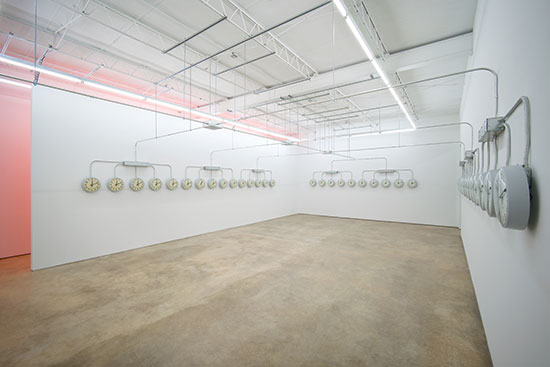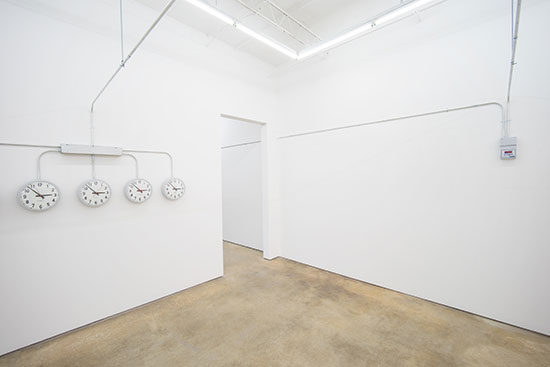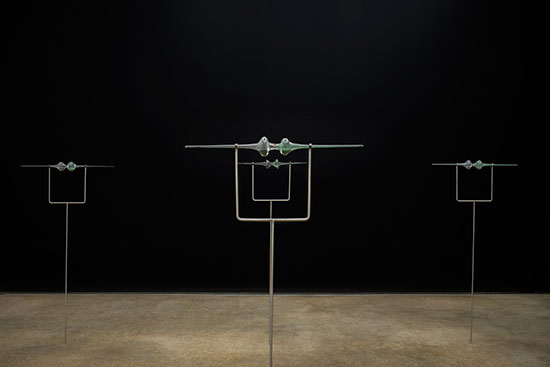In "Power-Line," Agustina Woodgate's impressive show at Spinello Projects in Miami, the artist has wedded conceptual conundrums to a subversive visual experience regarding time and money. The exhibition links performance art to minimalism to the Kinetic, machine-like sculptures of Jean Tinguely—a stunning performance in itself.
Swiss sculptor and experimental artist Jean Tinguely (1925-1991) was a leading figure in the Kinetic art movement, which came to prominence in the 1950s and then gradually declined in the 1960s. Its emphasis on movement, though, dates back to around 1910, with ties to the Futurists and Marcel Duchamp.
Tinguely is perhaps best known for the 1960 performance of his self-destructing sculpture "Homage to New York" at the Museum of Modern Art. Composed of found objects which he ingeniously mechanized to create his Kinetic sculpture, his work reflected a sardonic attitude toward ideas that advances wrought by the Industrial Revolution and technology were always beneficial.
Like Tinguely, Woodgate is interested in how the accelerating pace of technological change affects human life. And, in the 21st Century, Woodgate's artistic career reflects more advances than even Tinguely might have imagined. In 2011, she co-founded www.RadioEE.net, which her website describes as a "nomadic, bilingual, event-based radio broadcast." The site has generated broadcasts by partnering with various art venues, public festivals, and academic conferences.
According to information provided by Spinello Projects, Woodgate has attracted international attention for more than a decade: She has created projects for the 9th Berlin Biennial, the Faena Arts Center in Buenos Aires, the Bass Museum of Art in Miami, and other venues. Grants she's received include those from Association of Latino Arts and Culture and Joan Mitchell Foundation.
At Spinello Projects, the artist has created a vivid case for the consequences of creeping authoritarianism, fueled by the kind of fast-paced industrial innovation that so famously preoccupied Tinguely with his absurdist, machine-like sculptures.
When visitors encounter Woodgate's National Times, the first of her two installations at Spinello, they walk down a long hallway painted orange. The color's so loud it hurts the eyes. It's reflected on the opposite wall as a fuzzy, lighter shade, reminiscent of the disorienting glow in an installation by James Turrell. The wall is painted with the shade of fluorescent orange that OSHA has approved to signify “warning.”
.

"National Times" by Agustina Woodgate at Spinello Projects. Courtesy of Spinello Projects.
.
This wall generates a sense of unease—amplified by a persistent hissing sound that recalls the ominous warnings from rattlesnakes in Western B-movies. But this is the sound of ink on dollar bills being sanded away; Woodgate destroyed the bills' value to create ink dust for the second part of her exhibit here. Incorporating the sanding sound adds to her art's underlying emphasis on performance.
Turning left at the end of the orange hallway, visitors will see the rest of National Times and will discover how discomforting it is to enter a room with three walls lined with evenly spaced clocks. Each of the 40 clocks tells the same time. Round, bland institutional clock faces look down on visitors with stern, oddly familiar authority.
.

"National Times" by Agustina Woodgate at Spinello Projects. Courtesy of Spinello Projects.
.
At first they resemble the traditional clocks most everyone has seen at workplaces or in classrooms. The timepieces summon age-old questions: Isn't it time to quit yet? Will this class ever end? The clocks also seem to mimic a newsroom, fancy hotel or bank eager to establish global prominence by indicating the time in cities around the world. Yet these references deliberately confound: Why would any business display so many clocks in the same place telling the same time?
Scanning the 40 clocks, the visitor soon realizes they only appear to be telling the same time. The second and minute hands on some clocks are not synchronized.
.

"National Times" by Agustina Woodgate at Spinello Projects. Courtesy of Spinello Projects.
.
In fact, trying to keep track of how one clock differs from another exerts an almost hallucinatory sensation of having stumbled into a paradoxically timeless zone, where there's no reliable way of telling how much time has passed. Then, periodically, a master clock coordinates all 40 clocks when they slip out of synch.
With so much redundancy and near-redundancy, more disturbing questions arise: Why do they resemble so many eyes? Could they be surveillance cameras?
Posing questions like these makes National Times an intriguing installation. Its conceptual array of thought-provoking conundrums delivers a smart, thematic complement to Woodgate's second installation, $8.05, encountered after the visitor has walked through National Times.
Referring by its title to Florida's current minimum wage, $8.05 is composed of eight hourglasses suspended on horizontal stainless steel rods, with each attached to a concrete base. They're displayed in a single gallery like elegant Minimalist sculpture, composed of both sturdy and fragile materials. The look is coolly contemporary, and yet the hourglass itself goes back centuries as a timekeeper.
.

"$8.05" by Agustina Woodgate at Spinello Projects. Courtesy of Spinello Projects.
.
The sculptures all contain the “value” of Florida's minimum wage: powdery, bluish-green particles of ink scraped from bills totaling $8.00, while a nickel is embedded in each sculpture's concrete base. Also sealed inside the hourglass are several puffs of Miami air, surely a fleeting reference to Duchamp's famous readymade, "Paris Air."
Woodgate has also further documented her sanding process to create $8.05: Several works on paper in the show, including "Single," reflect outlines of the sanded down dollar bills and ghostly residue left by the sanding.
The artist here subverts the old adage "Time is money," credited to Benjamin Franklin, whose likeness adorns the $100 bill. Maybe, her art suggests, Franklin's out of date?
In our post-Great Recession era, when there's much talk about the economy stagnating instead of growing, Woodgate's installations create vivid metaphors for the ebbing away of time and money, daring to imply that longtime accepted markers of value may be losing, one could say, their currency.
According to the artist, the elaborate physical logistics of National Times reflect timekeeping techniques prevalent in schools and factories. Adapted from a system used in an elementary school, the 40 so-called "slave clocks" are connected through an electrical grid to a master clock, which is fitted with a GPS antenna to connect with the National Institute of Standards and Technology satellite time base. National Times is also dependent on energy supplied by Florida Power and Light.
Attached to the minute hands of each clock are strips of sand paper, a material Woodgate has used to create previous artworks by erasing political boundaries on globes. As the hands pass over the clock's face, they slowly erase the numerals. Commonly accepted ways to measure the passage of time will eventually disappear. When that happens, the performance of "Power-Line" concludes.
Woodgate admits that the erasure will probably not be complete by November 8, when the show closes. In a future installation, she said, the process of erasure would simply continue from where it had ended at Spinello Projects.
"Power - Line" is especially appropriate now. The 2016 U.S. presidential race has ignited scores of debates about work: the jobless rate, the number of jobs migrating overseas, workers being stiffed, and the minimum wage differing from state to state. Uber drivers have eroded the taxi industry. Moreover, as the digital landscape inexorably expands, self-driving cars move forward in the news and in reality.
"My interest was to visualize the value of work, an hour of work," Woodgate said in a phone interview on October 13, 2016. "Not only because it's less than a month away from the presidential election," she said, "but for the future of automation. Machines are more and more producing the labor of humans. What is the relationship we have with work?"
Increasingly, automation appears to shape the artist’s own relationship with the work of making art. Referring to National Times, she explained, "In this case, the machines are doing the work themselves." It's not a stretch to say Jean Tinguely would be fascinated by "Power-Line."
____________________________________
BASIC FACTS: "Power-Line" by Agustina Woodgate is on view September 8 through November 8, 2016, at Spinello Projects, 7221 NW 2nd Avenue, Miami, FL 33150. www.spinelloprojects.com
____________________________________
Copyright 2016 Hamptons Art Hub LLC. All rights reserved.
